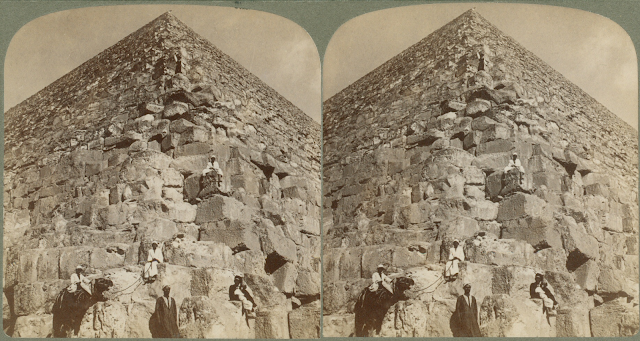Looking up the northeast corner of the Great Pyramid, Egypt
“Here the vast mass has full sway over us; it overpowers and overwhelms us.… See how the great block dwindle and dwindle as the eye soars upward and follows them until they merge and melt into the mountainous bulk of the mass; and still it rises ever higher, to the distant peak where the Arab, waving his black garment, seems like a tiny insect.…"
“Here is the very embodiment and potentiality of that ancient state of which the Pharaoh was the soul. Think of the organization of men and means, of force and skilled labor, required to quarry these 2,300,000 blocks, each weighing about two and a half tons, to transport them across the Nile and lift them to the rising courses of this ever-growing monster, till the capstone is 481 feet from the pavement. The base of the sea of stone which forms each face is 755 feet long, and the square which it forms on the ground includes a field of over thirteen acres. When you have walked around it you have gone over 3,000 feet—some three-fifths of a mile."
“Perhaps you are saying to yourself that this masonry looks rather rough in exterior finish to be the product of skilled workmen. Quite true; but this was not originally the final exterior finish. When completed, the pyramid was sheathed from summit to base in magnificent casing masonry, so skilfully set that the joints were almost indiscernible.… It was still in place when the first Greek visitors beheld the pyramid and wrote of it.… It was removed sometime between the thirteenth and sixteenth centuries by the Moslem builders of Cairo, who used the blocks thus gained for building the mosques and tombs and houses there.”
(From “Egypt Through the Stereoscope,” by James H. Breasted, Ph. D.D., with twenty patent maps and plans. Copyright 1905 by Underwood & Underwood.)

Comments